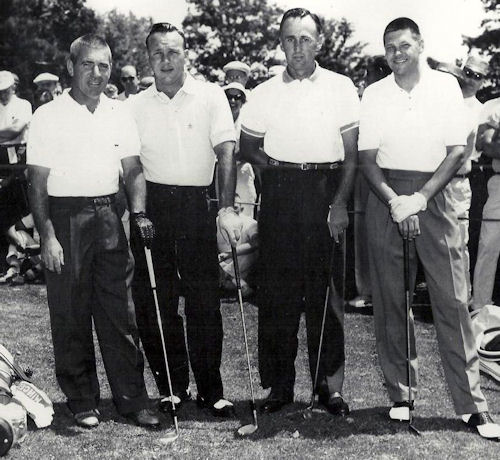The Post-Journal
by Jim Riggs
January 14, 2012
Some Of Golf’s Best Played Here
About 50 years ago it wasn't.
This week I began perusing information about Chautauqua Sports Hall of Fame inductee, Ben Bishop, who passed away in 1970 at the age of 54. He was one of the top amateur golfers, if not THE top amateur golfer, in the area from the late 1940s into the 1960s. Not only did he dominate the club championship at Moon Brook Country Club by winning it 12 times, but away from his home course Bishop won the Chautauqua County Amateur six times.

A highlight for Bishop had to be on July 27, 1959, when he was the only amateur to complete a foursome of three pros who played an exhibition at Moon Brook.
Bishop teamed with Moon Brook pro Toby Lyons in a match against Arnold Palmer and Art Wall, Jr., who won the match, 5 and 4. Bishop showed he belonged in the foursome with the pros because he shot a 1-under-par 70 while Palmer shot a 3-under 68 and Wall a 69.
But these weren't just any pros. Just a couple of months before, Wall was putting on the green jacket as the Masters champion. And who helped Wall put on the jacket? Palmer, who was the defending champion. And then Palmer won it again in 1960.
Not only were they playing at Moon Brook, but it was on a Sunday in late July. It was a week when there was no PGA Tour event, so on Saturday Palmer and Wall took part in an exhibition at Harrisburg, Pa., and then they both boarded Palmer's private plane and flew to Jamestown. After the exhibition at Moon Brook, Wall stayed for dinner before heading to Mansfield, Ohio, the next day for another exhibition. Palmer immediately flew to Latrobe, Pa., because he hadn't had dinner at home all week.
It was a different era in pro golf. They were playing in these exhibitions because they needed the couple of hundred dollars they were paid. Wall went on to lead the PGA Tour money list in 1959 with a total earnings of $58,167. Today that would be approximately $452,203. And the money leader in 1958 was Palmer with $42,607.
So not only were they back-to-back Masters champions, but also the back-to-back money leaders. But even in the 1950s, pro golfers needed more money and playing exhibitions was the way to earn it.
That contrasts with today when pro golfers can earn more from endorsements than from their tournament winnings. And I do mean more. For instance, in 2010 Tiger Woods had $2,294,116 in tournament earnings, but $60,000,000 in endorsements. And for Phil Mickelson, it was $4,185,933 in winnings and $57,000,000 in endorsements.
That exhibition at Moon Brook wasn't the first time Bishop played with a touring pro. In 1955 George Bayer, the John Daly of his time when it came to driving distance, came to Moon Book and Bishop played in the exhibition. A couple of years earlier, Ben Hogan and PGA Championship winner Jay Hebert also played at Moon Brook.
In earlier decades, many big-name pros played exhibitions at Chautauqua Golf Club. The first was in 1929 when Walter Hagen, who had won the PGA Championship five times, and Horton Smith, who would go on to win the first Masters in 1934 and again in 1936, toured the course.
Smith returned to Chautauqua for an exhibition on Aug. 7, 1930, and was joined by Gene Sarazen, Johnny Farrell, the 1928 U.S. Open champion, and Jack Cawsey, who was the pro at Chautauqua. Farrell and Sarazen teamed up and defeated Smith and Cawsey, 2 and 1.
A couple of highlights were that Sarazen had a double-eagle 2 at No. 10, which is now No. 10 on the Lake Course. But on No. 11, he recorded a double-bogy 6. He had a similar disaster at the par-3 sixth hole where he put two balls in the water.
The best score was recorded by Farrell who shot a 34-34-68.
Visits by professionals then became a habit at Chautauqua beginning in 1937 when Sarazen and Paul Runyan played the course. In 1938 it was Lawson Little, the 1940 U.S. Open champion, and Harry Cooper followed by Byron Nelson and Smith in 1939 and in 1940 Sam Snead and Henry Picard, the 1938 Masters champion, were there. In 1941 it was Craig Wood, who won the U.S. Open that year, and Hogan who visited, and in 1942 it was Smith and Jimmy Thompson.
From 1942-45, probably because of World War II, there were no exhibitions. They continued in 1946 with Porky Oliver and Sam Byrd, who returned in 1947. In 1948, Hogan, who won the U.S. Open that year, and Jimmy Demaret played at Chautauqua and the last visit by pros to the course was in 1949 when Cary Middlecoff, winner of that year's U.S. Open, and Lloyd Mangrum, the 1946 U.S. Open winner, took part in an exhibition.
In the next decade, golf gained in popularity mainly because of television. More tournaments began being televised in the late 1950s, featuring its ''star'' - Palmer. Tournament purses increased and when there weren't tournaments, there were made-for-TV events which were a source of extra money for pro golfers, so scheduling exhibitions wasn't as important.
But those exhibitions were important in the years before and the main beneficiaries were golf fans.
The additional financial assistance of the community is critical to the success of the Chautauqua Sports Hall of Fame.
We gratefully acknowledge these individuals and organizations for their generous support.













